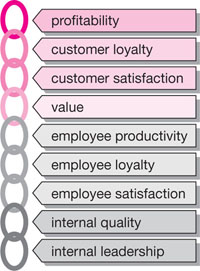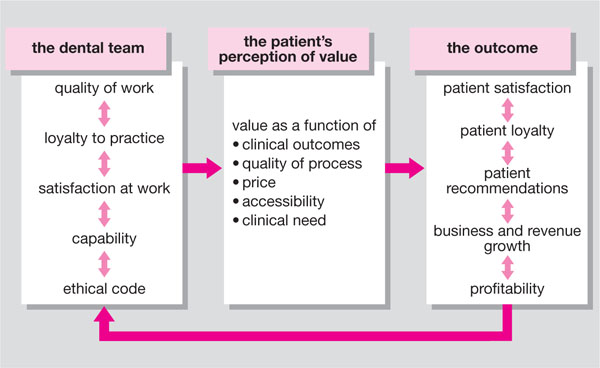Chapter 1
What Business Are We In?
The purpose of any business is to generate profit. The view that health care and profit generation are somehow mutually exclusive and require the providers of healthcare to abandon their commitment to clinical quality and to uphold the highest professional ethics is one myth which should be dismissed from the outset.
The business of dentistry is about providing high-quality clinical care in a high-quality environment. The challenge in the business of dentistry is to provide it profitably and in a way that makes patients appreciate and value the treatment they receive. To meet this challenge we must apply the principles of commerce. We must have an understanding of the meaning and purpose of marketing, knowledge of human psychology and an appreciation that the title of “patient” confers a special status on any member of the public whose behaviour will be that of a dental “consumer” or “client”.
Customer or Patient?
There is no need to deliberate as to whether we should call our patients “customers”, “consumers” or “clients” because they are all three. What makes them patients is the ethical bond and duty of care that attaches them to the healthcare profession. We will use all these terms in this text to reflect the origins of the principles that are under discussion. We must remember that in any business high levels of profitability and growth are primarily stimulated, driven and sustained by customer loyalty. The business of dentistry is no exception.
Patient Care and Profit
In this book we have chosen to take the view that if you look after your patients, then the profits will follow. In so doing we must understand the meaning of “looking after”. But we must remember that there is more to looking after people than looking after their teeth, and when we create the environment in which we want to “look after” them, then we must be sure that that environment is built on a sound business principles with profit generation in mind. No profit means no practice and we lose the opportunity of looking after people.
The Service Profit Chain
In 1994, Heskett developed the concept of the “service profit chain” (Fig 1-1). Its core principles demonstrate perfectly the key linkages that are the business of dentistry. The service profit chain, developed from analyses of successful service organisations, helped to establish the relationships between profitability, customer loyalty, employee satisfaction and productivity. Further exploration of these relationships led to the publication in 1997 of Heskett, Sasser and Schlesinger’s book The Service Profit Chain: How Leading Companies Link Profit and Growth to Loyalty, Satisfaction, and Value. We can adapt its customer-orientation slant and make it relevant to the business of dentistry (Fig 1-2).

Fig 1-1 The service profit chain.

Fig 1-2 The service profit link.
This approach demonstrates that there are strong links between:
profit and patient loyalty
employee loyalty and patient loyalty
employee satisfaction and patient satisfaction.
Mission Statement
One way to communicate and share your vision is to prepare a mission statement. Mission statements have become a part of business culture and many dentists have adopted this practice. Your mission statement should be able to tell your practice story in less than thirty seconds. Here are ten tips to help you create an effective mission statement.
-
An effective mission statement should state who you are, what you do, and what you stand for.
-
Remember your mission statement is not a slogan or an advert.
-
An effective mission statement is best developed with input from all the team. Even if certain members think it is silly or have no ideas (both are common), they will buy into the concept more if their opinion is solicited.
-
Take time to create your mission statement. Put it away and look at it again a week later and refine it.
-
Look at other mission statements to get some ideas. (Do not copy your statement: it has to be about you.)
-
Keep the statement simple and honest. Avoid humour and grandiloquence. (Aim for between one and four sentences.)
-
Avoid saying how great you are or what great quality and what great service your practice provides. (Using such clichés makes you indistinguishable from the rest. Have you ever seen any business say otherwise?)
-
You must believe in your statement. If you do not believe it, then it is a lie and your patients will know it is a lie.
-
Use your mission statement to supplement your marketing communications.
-
Make certain everyone in the practice gets a copy of the statement. Use your mission statement in your staff manual and at practice meetings, and post it in the practice.
Some examples of phrases used by dental bodies corporate in their mission statements are shown in Table 1-1.
| Treatment-related | “quality dental care”; “highest quality of care through sophisticated treatment modalities”. |
| Patient-centred | “putting patients first”; “dental care with you in mind”; “emphasis on excellent patient careaffordable” |
| Environmental (practice and staff) | “supportive environment”; “friendly and relaxed atmosphere”; “state-of-the-art practices”; “efficient and highly focussed team” |
The Nuts and Bolts of the Business of Dentistry
The nuts and bolts of the business of dentistry are no different from those of any other business. To succeed, you must have:
-
leadership
-
vision
-
effective teamwork
-
business acumen
-
an understanding of services and products
-
customer focus.
Leadership and Vision
Dr John C. Maxwell, author of The 21 Irrefutable Laws of Leadership, notes, “everything rises or falls on leadership”. He describes a good leader as someone who “knows the way, goes the way and shows the way” and observed that a good leader takes a little more than his share of the blame and a little less than his share of the credit. In your practice, good leadership is about setting direction – sometimes a change of direction. It is about clarifying your vision, helping your team to share that vision and motivating them to want to achieve it. Vision is about the future. It is where we will all spend the rest of our life.
As a leader in your business, you should have the ability to:
-
Challenge processes. Find a process that you believe needs to be improved the most and act on it.
-
Share your vision with the team.
-
Enable and empower your team to act.
-
Model the way. A “boss” simply tells others what to do; a “leader” demonstrates it can be done.
-
Inspire. Share success with your team. Keep the pain to yourself.
In ten short chapters on “developing the leader within you”, Maxwell summarises what leadership is all about. He concludes that:
-
The definition of leadership is influence.
-
The key to leadership is about setting priorities.
-
The most important ingredient of leadership is integrity.
-
The ultimate test of leadership lies in creating positive change.
-
The quickest way to gain leadership is to problem solve.
-
The extra plus in leadership is attitude.
-
Your most appreciable asset is your people.
-
The indispensable quality of leadership is vision.
-
The price tag of leadership is self-discipline.
-
The most important lesson of leadership is to commit to staff development.
History reveals many inspired visions, and few are as remarkable as that of John F Kennedy when on 25 May 1961 during a joint session of Congress he shared his vision for the United States: “I believe that this nation should commit itself to achieving the goal, before this decade is out, of landing a man on the moon and returning him safely to the Earth.” The team at NASA realised that goal (although John F Kennedy did not live to see his vision become reality).
There are essentially three styles of leadership. The styles and their characteristics are summarised in Table 1-2. Another useful model is to look at the preferred focus of the leader: are you people-focused or output-focused? This relationship can be explored in a model developed by Robert Blake and Jane Mouton in 1964 known as the managerial grid (Fig 1-3). In this model, the 2–2 style shows little concern for people or output and may reflect a permissive approach to practice management. The 3–9 style is people-focused, but if there is insufficient focus on output, then the financial status of the practice may be vulnerable. This position is difficult to sustain, particularly if practice costs are not being met. The 9–9 approach is clearly a winning strategy – and reflects a “win-win” approach to leadership thinking.
| Autocratic | Authoritarian. Decisions are made without consultation – a very dictatorial approach to decision-making. Can make others in the team feel isolated and alienated. |
| Democratic | A participative approach. Decisions are made jointly and team involvement is encouraged. The team is made to feel important and has ownership of decisions and outcomes. |
| Laissez-faire | Sometimes known as the “permissive” style of leadership -there is abdication of responsibility and lack of control. The business has no real direction. |
Stay updated, free dental videos. Join our Telegram channel

VIDEdental - Online dental courses


